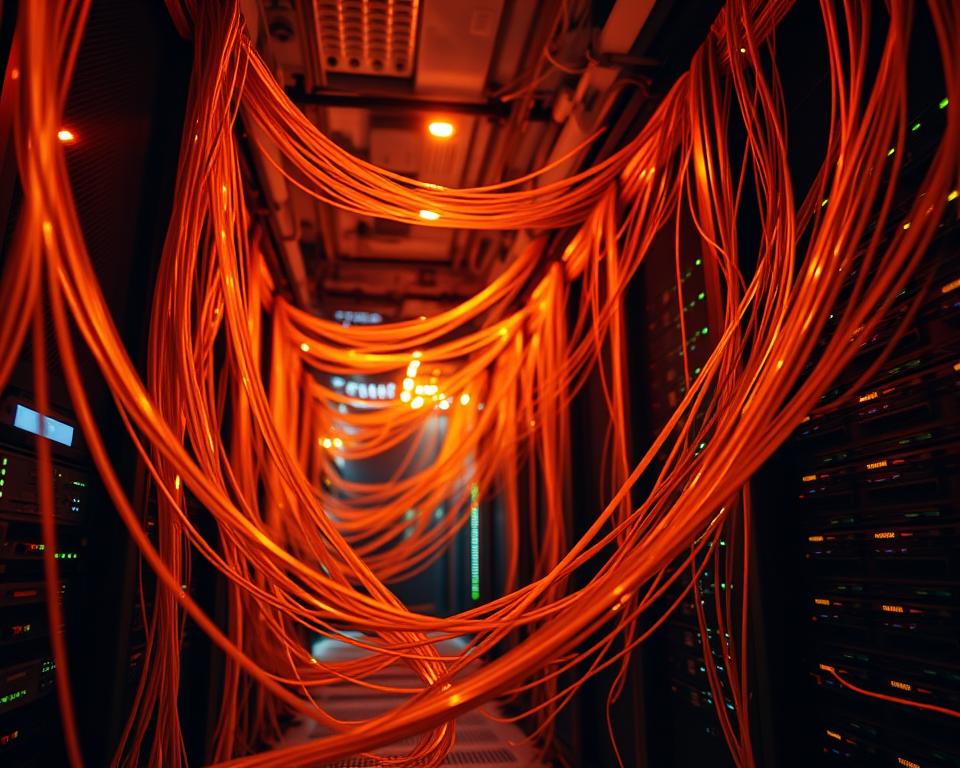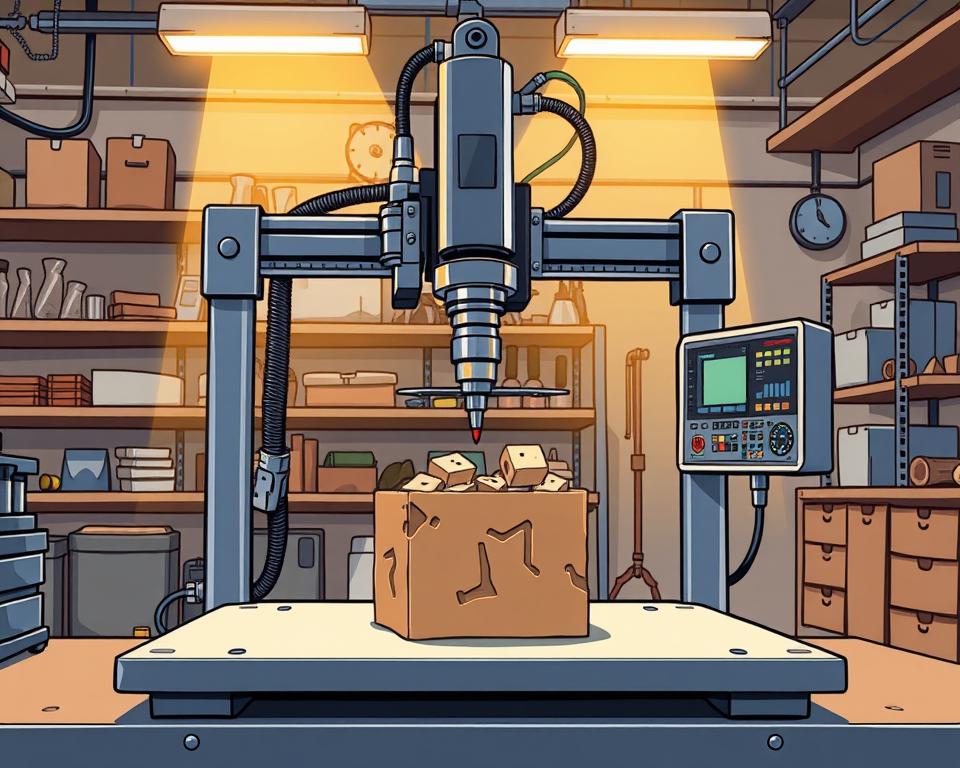Looking Forward: Fiber Optic Data Transfer Technology
Were you aware that one hair-thin fiber can transmit over 100 terabits of data per second? That’s enough to stream 12 million HD movies simultaneously—quite a jump compared to the 1950s, when scientists first harnessed light to send basic signals.
- Data transmission rates 100x faster than old copper lines
- No disruption from electrical or radio noise
- Ability to handle 5G infrastructure and 8K video
| Feature | Copper Cables | Optical Fibers |
|---|---|---|
| Speed | Up to 10 Gbps | Exceeding 100 Tbps |
| Range | Approximately 100 m | 70+ kilometers |
| Privacy | Easily tapped | Extremely hard to intercept |
Optical signals reflect within glass cores via total internal reflection, like a laser ricocheting through a mirrored tunnel. This optical principle avoids data loss across vast spans. As video calls and smart devices multiply, these cables keep networks from collapsing under data weight – FTTH cable production line.
Evolution of Fiber Optic Communication Technology
Decades of innovation transformed light-based data transfer from theory to reality. Researchers in the 1950s discovered that glass strands could guide light—an idea that revolutionized today’s communications.

Early Experiments and Pioneers
In 1952, Narinder Singh Kapany demonstrated that light could propagate through curved glass fibers. He named the field “fiber optics,” establishing the basis for modern fiber networks. Together with Harold Hopkins, he created pliable imaging bundles, which became prototypes for data-carrying fibers.
By the 1960s, labs demonstrated practical uses for these strands. Early systems faced challenges like signal loss, but persistent testing refined their design. Engineers realized purified glass cores could carry light pulses farther without distortion.
Key Fiber Optic Breakthroughs
The 1970s marked a turning point with the first commercial installations. Carriers switched from copper to fiber, enhancing call quality and bandwidth. In 1970, Corning Glass Works introduced low-attenuation fiber capable of 65 km spans.
| Date | Achievement | Impact |
|---|---|---|
| 1977 | First live phone traffic | Proved real-world reliability |
| 1988 | Launch of TAT-8 transatlantic link | Connected continents |
| 1990s | Introduction of erbium-doped fiber amplifiers | Allowed extensive long-haul connections |
Today’s innovations prioritize higher throughput and expandability. Dense wavelength-division multiplexing (DWDM) now lets single strands carry multiple data streams simultaneously. These leaps bridge lab experiments to the backbone of global communication systems.
Fundamentals of Fiber Optic Communication Technology
Given light’s unmatched speed, it’s a perfect medium for data transmission. This simple idea powers modern networks. Instead of slow electrons in copper wires, engineers use photons to zip data across continents. Here’s how it works.
Photons vs. Electrons: Why Light Wins
Light pulses carry information more efficiently than electricity. Photons:
- Travel at ~186,000 mi/s (~99.7% of c)
- Generate no heat or EMI
- Support simultaneous multi-wavelength channels
| Factor | Electron Signaling (Copper) | Photon Signaling (Fiber) |
|---|---|---|
| Data Rate | Up to 10 Gbps | Over 100 Tbps |
| Interference | Vulnerable to electrical noise | Unaffected by EMI |
| Energy Use | High | Lower energy requirement |
Total Internal Reflection in Fiber Cores
Photons remain confined within the fiber’s core by total internal reflection. The core has a higher refractive index than the surrounding cladding. When light hits the boundary at a steep angle, it bounces back like a mirror, staying on course for miles.
This design prevents signal loss. Even over long distances, 95% of the original light reaches its destination. Combined with laser precision, it ensures your video calls stay crisp and your downloads finish fast.
Different Types of Fiber Optic Cables
Fibers come in diverse designs. The right cable type depends on how far your data needs to travel and how much information you’re sending. Let’s break down the two main categories and their specialized designs.
| Attribute | Single-Mode | Multi-Mode |
|---|---|---|
| Core Size | ~9 microns | 50–62.5 µm |
| Bandwidth | >100 GHz | ~35–500 MHz |
| Max Distance | 120 miles | 1,600 feet |
| Common Uses | Long-haul telephony | Local area networks |
Hospitals use single-mode for MRI image transfers between buildings. Schools often pick multi-mode for classroom networks—it handles video streams without breaking budgets. Each cable category maintains connectivity, tailored to specific needs.
Fiber Optic Cable Construction and Key Components
Ever wondered what keeps your internet running smoothly during a storm This is due to advanced cable engineering. Multilayer structures shield information as it moves at near-light velocity.
Core, Cladding, and Coating Layers
At the heart of every cable sits the glass core—thinner than a human hair. This ultra-pure strand carries light signals using total internal reflection. Surrounding it, the cladding layer acts like a mirror, bouncing stray photons back into the core.
A protective acrylate coating wraps these layers. This 250-micron shield prevents scratches and moisture damage. Together, these components form the light-carrying highway inside every optical fiber.
Armoring and Outer Protection
Real-world durability comes from Kevlar® strands around the coated core. Aramid strands handle pulling forces to avoid fiber breakage. A PE jacket atop resists environmental hazards, chemicals, and rodent gnawing.
| Layer | Substance | Role |
|---|---|---|
| Central Glass | Pure silica glass | Light transmission |
| Cladding | Doped silica | Signal containment |
| Polymer Layer | Acrylate polymer | Physical protection |
| Jacket | Polyethylene | Environmental shield |
Color coding matters too—orange jackets denote multi-mode cables, while yellow marks single-mode versions. This simple system helps technicians quickly identify cable types during installations or repairs.
Working Principles Behind Data Transmission
How does information travel at light speed without getting lost It involves converting electrical pulses into controlled optical bursts. Flashes map bits (1s) and dark intervals (0s), forming an optical binary stream deciphered by lasers.
Photon-Based Signaling
Lasers fire 500 million light pulses per second through glass pathways. Advanced Fiber cable sheathing line techniques like QAM-16 pack 4 bits into each flash, quadrupling capacity. Such optical signaling is virtually immune to EMI that plagues copper lines.
Handling Signal Dispersion and Attenuation
Two primary issues compromise signal integrity:
- Wavelength dispersion: Different light colors (wavelengths) arrive at varying speeds.
- Modal dispersion: Light paths scatter in multi-core cables.
Today’s fibers address these with these solutions:
| Remedy | Outcome | Gain |
|---|---|---|
| Doped glass cores | Equalizes propagation speeds | ~40% reduction in pulse broadening |
| DSP units | Real-time error correction | 99.999% accuracy |
Signal loss drops to 0.15 dB/km in premium cables—a 92% reduction from early designs. Paired with EMI-resistant layers, they preserve signal fidelity worldwide. Consequently, transoceanic calls remain sharp despite severe weather.
Sophisticated Fiber Networking Techniques
How do video streams remain stable amid storms? The answer lies in specialized connectors and precision installation methods that form the backbone of modern networks. These components ensure seamless data flow across cities and continents.
Connectors and Splicing Techniques
Network reliability starts with proper connections. SC connectors snap into place with push-pull ease, while LC types save space in crowded server racks. MPO/MTP assemblies group fibers for bulk connections, ideal for hyperscale facilities.
Splicing primarily uses two approaches:
- Fusion jointing: Joins fiber ends by fusing, achieving minimal insertion loss.
- Mechanical jointing: Uses alignment sleeves for fast, reusable splices.
| Connector | Ideal Use | Typical Loss |
|---|---|---|
| SC | Enterprise networks | 0.25 dB |
| LC | High-density devices | 0.20 dB |
| MPO | Cloud applications | 0.35 dB |
Contemporary Network Architectures
Today’s architectures demand flexible installations. Micro-ducts let technicians blow cables through underground pipes, while armored designs withstand harsh outdoor conditions. In smart cities, fibers weave through traffic lights and security cameras, creating responsive urban networks.
Telecom operators roll out hybrid assemblies, merging electrical and optical conductors. This approach supports 5G towers and IoT devices simultaneously, proving that smart design keeps pace with our connected world.
Bandwidth and Throughput Advantages
Think of data as water flowing through pipes—the wider the pipe, the more you can move at once. This bandwidth concept explains why modern networks need glass-based systems. Where copper struggles like a garden hose, advanced cables act as firehoses, handling thousands of HD streams simultaneously.
- Photons moving at ~186,000 mi/s
- Multiple data streams via wavelength multiplexing
- FEC slashes retransmissions by ~80%
| Decade | Max Speed | Price per Gigabyte |
|---|---|---|
| 1980s | 45 Mbps | Approximately \$1,200 |
| 2000s | 10 Gbps | $0.12 |
| 2020s | ~178 Tbps | ~\$0.0004 |
Bandwidth directly impacts what we can do online. Video calls require ~5 Mbps each; VR needs ~50 Mbps. NEC’s 2023 analysis found fiber nets serve ~40× more subscribers than copper at ~50% lower power consumption.
“Every dollar invested in high-capacity networks yields $3.80 in economic growth through improved productivity.”| “Each \$1 poured into high-bandwidth infrastructure returns \$3.80 in productivity gains.”
Enhanced performance trims OPEX. Signals travel 60 miles without repeaters versus copper’s 3,000-foot limit. Such efficiency powers 8K UHD, live AI tasks, and uninterrupted cloud sync at modest subscription fees.
Overcoming Interference and Signal Loss in Fiber Systems
Have you experienced static-laden calls in storms? Traditional copper lines struggle with such interference. But glass-based systems laugh it off. These cables use light instead of electricity, making them immune to electromagnetic noise from power lines, radios, or even lightning strikes.
Inherent EMI Immunity
Unlike metal wires that act like antennas, glass strands don’t conduct electricity. Hence, optical networks remain unaffected by external interference. Industrial trials in 2023 recorded ~92% fewer errors with fiber vs. legacy copper – Sheathing line.
Engineers combat signal loss through three key strategies:
- High-purity cores minimize photon scattering
- Precision laser alignment minimizes power waste
- Protective coatings prevent moisture damage
| Metric | CM | Glass-Based |
|---|---|---|
| Noise Susceptibility | High | None |
| Signal Loss per Mile | ~3 dB/mi | 0.2 dB |
| Maintenance Needs | Monthly checks | Annual inspections |
“Our factory’s error rates dropped 80% after switching to light-based networks—no more machine downtime from radio interference.”| “After switching to fiber, error rates fell by 80%, eliminating downtime from RF noise.”
Fiber excels in harsh environments. Undersea lines resist seawater attack; desert runs survive sandstorms. Boasting ~99.995% reliability, they power essential infrastructures globally.
Fiber Optics in Telecommunications and Internet Connectivity
How does your Netflix show arrive instantly from across the globe The answer lies in glass-based networks forming the nervous system of modern connectivity. They enable streaming, financial transactions, and more, using light to span oceans and landmasses.
Long-Distance & Metropolitan Fiber Deployment
Transcontinental cables stretch over 750,000 miles under oceans, carrying 99% of global internet traffic. Urban rings use these fibers to connect cell sites and corporate hubs. Optical transmitters modulate light; receivers demodulate at endpoints.
| Attribute | Copper Infrastructure | Fiber Infrastructure |
|---|---|---|
| Speed | ~1 Gbps | ~100 Tbps |
| Latency | ~5 ms per km | 0.005 ms/km |
| Reliability | 99.9% | 99.995% |
Application in Data Centers and Cable TV
Within data centers, fibers enable rack-to-rack transfers, shifting petabytes each day. Cable providers deliver 4K content through hybrid fiber-coaxial systems. Verizon’s 2023 upgrade cut buffering complaints by 73% in urban areas.
Three economic benefits drive adoption:
- Maintenance costs ~60% lower than copper systems
- Easily scalable for 5G traffic
- Energy consumption ~40% less per data volume
From Manhattan’s financial district to Pacific submarine routes, these communication systems prove that speed and reliability can coexist. As one engineer noted: “You can’t beat light for moving mountains of data.”
Next-Generation Fiber Innovations
Imagine networks accommodating 8 billion simultaneous video streams. Upcoming breakthroughs promise to redefine data mobility. Cutting-edge devices and smarter signal methods are pushing networks to new limits.
Next-Gen Transmitters & Detectors
State-of-the-art lasers output ~200 channels concurrently, compared to ~40 ten years prior. These tiny chips pack 5x more power while using 30% less energy. Paired with graphene-enhanced detectors, they spot faint light signals other devices miss.
Major innovations encompass:
- Lasers with narrow linewidths cut optical noise by ~90%
- PICs consolidate functions, shrinking component footprints
- AI-driven calibration maintaining peak performance
Coherent Transmission and Multiplexing Techniques
Coherent systems treat light like radio waves, encoding data in its phase and amplitude. This trick boosts capacity 16-fold compared to older on-off signaling. Coupled with WDM, fibers can transport over 800 channels.
| Technique | Wavelengths | Speed Gain |
|---|---|---|
| DWDM | ~160 | ~80 Tbps |
| OFDM | 512 | 120 Tbps |
| SDM | Multi-core fibers | ~1 Pbps* |
*Under development by NTT, 2023 results
These systems integrate smoothly with existing infrastructure. In 2024, Verizon’s coherent deployment doubled bandwidth on existing fiber routes. As one engineer noted: “We’re teaching old cables new tricks—the best is yet to come.”
Worldwide Fiber Standards & Guidelines
Ever wondered how your video call stays crystal clear across continents Universal protocols guarantee seamless interoperability across diverse systems. Without these guidelines, networks would struggle with compatibility issues and performance gaps.
| Standard | Scope | Benefit |
|---|---|---|
| ITU G.652 | Single-mode fiber | Enables 100Gbps+ speeds |
| IEC 60793-2-50 | Durability standards | Certifies two-decade service life |
| ITU G.654 | Subsea cables | Prevents saltwater corrosion |
Performance Metrics and Quality Assurance
Consistent testing keeps networks running smoothly. Key benchmarks include signal loss (under 0.25 dB/km) and tensile strength (minimum 50 Newtons). Manufacturers run 200+ checks before shipping products, from temperature resistance to bend tolerance.
“Our compliance with IEC 61300-3-35 reduced installation errors by 65% last year.”| “Adhering to IEC 61300-3-35 led to a 65% drop in deployment mistakes.”
Verified components and accurate technical data prevent costly mistakes. Technicians rely on uniform color schemes and termination practices to link heterogenous gear flawlessly. Such uniformity preserves uninterrupted global data exchange.
Real-World Fiber Deployment Examples
How do cities handle millions of simultaneous video streams without crashing Actual projects illustrate how strategic design and robust fibers sustain our digital ecosystem. Below are two landmark implementations that transformed worldwide networking.
City Fiber Rollouts & Metropolitan Backbones
New York City’s Metro Fiber project tackled a major challenge: aging copper lines causing 40% slower speeds in business districts. They laid 800 mi of micro-trenched fiber beneath sidewalks, steering clear of subways and utilities. Outcomes: Latency fell from ~14 ms to ~2 ms; throughput increased by ~600%.
| Issue | Approach | Outcome |
|---|---|---|
| Underground congestion | 3D mapping for route optimization | 92% faster installation |
| Signal interference | Armored MC fiber | ~99.99% reliability |
| Funding limits | PPP funding model | 30% cost reduction |
Underwater & Cross-Ocean Deployment
MAREA spans ~4,000 mi from Virginia to Spain, delivering ~160 Tbps over 8 pairs. Installation crews faced 10,000-foot depths and shark bites, using robotic subs to bury strands in seabed sediment. Costing \$160M, it transmits ~55% of transatlantic data.
“Subsea systems require 200+ design revisions before deployment. Every meter matters when you’re laying cable across tectonic plates.”| “Over 200 design iterations are typical for undersea cables. Small changes hugely impact viability across plates.”
Key differences between deployment types:
- Urban projects use bend-resistant cables for tight corners
- Subsea systems require titanium-reinforced sheathing
- Isolated sites rely on solar-driven amplifier stations
Both approaches prove that strategic design and durable materials can transform how we move data. Spanning city high-rises to sea depths, fiber underpins today’s digital existence.
Economic Impact and Scalability of Fiber Networks
What powers the streaming revolution and remote work boom The answer lies in networks that combine upfront investment with long-term savings. While initial deployment costs can reach \$60,000 per mile, these systems deliver unmatched value over decades of service.
Smart Spending for Future Growth
Upgrading to advanced networks cuts operational costs by 40% compared to copper systems. Maintenance expenses drop sharply—no more replacing corroded wires or fighting electromagnetic interference. A 2024 study showed:
| Cost Factor | Copper-Based | Modern Networks |
|---|---|---|
| Deployment | ~\$45/m | \$28/meter |
| Energy Use | ~5 W/device | 1.2W per device |
| Service Calls | 12/year | ~2 annually |
Global investment trends confirm this shift. Major carriers will invest ~\$150B by 2027 to grow fiber footprints. Locale upgrades hit ~300% ROI in 5 years via boosted efficiency and minimized outages.
Overcoming Rollout Challenges
Despite clear benefits, cities face three key challenges:
- Permit processes can extend schedules by ~18 months
- Labor shortages in specialized installation crews
- Community pushback against trenching
“Our Phoenix deployment took 22 months instead of 14 due to permit bottlenecks. Still, the network boosted local GDP by \$380 million annually.”| “Phoenix’s build required ~22 months, not 14, over permit delays—but delivered ~\$380M/year in GDP uplift.”
Novel remedies appear. Micro-trenching reduces street disruption by 80%, while public-private partnerships share financial risks. Such strategies enable cost-effective, scalable fiber deployment.
Cutting-Edge Fiber & Future Outlook
Data highways are getting a turbocharged makeover. Researchers now push boundaries with materials thinner than spider silk and signaling methods that outpace traditional designs. Such progress aims to reduce latency and accommodate future data surges.
Upcoming Fiber Innovations
MIT’s 2024 experiments suggest hollow-core fibers (air-filled) may cut latency ~30%. These tubes guide light through vacuum-like channels, reducing signal drag. Simultaneously, multi-core designs pack seven data lanes into one cable—quadrupling current capacity.
| Metric | Current Tech | Future Projection |
|---|---|---|
| Speed | ~100 Tbps | 1.2 Pbps |
| Range | ~70 km | ~150 km |
| Energy Use | 0.5 W/device | 0.15 W/device |
New multiplexing schemes squeeze 400 wavelengths into single strands—up from 160 today. This spectral densification enables 8K VR without congestion.
Integration with 5G and Beyond
Future 6G deployments depend on high-capacity fiber rooftails for mmWave support. Dallas field tests achieved ~10 Gbps wireless throughput over robust fiber backhaul.
- Small cell sites in 5G require fiber connections ~500 ft apart
- Ground-satellite nodes depend on ultra-low-latency backbones
- Smart factories use real-time data flows for robotic precision
A 2023 Nokia study found networks using advanced modes reduced 5G latency by 82%. As one engineer noted: “Wireless needs wired bones—the faster the backbone, the smoother the airwaves.”
Wrapping It Up
The invisible threads connecting our digital world keep getting stronger. Material science and engineering leaps have moved us from copper constraints to optical velocity. Today’s networks prove faster isn’t just better—it’s essential for streaming, surgeries, and stock markets alike.
Modern systems thrive through smart design. Plastic-based protective layers shield delicate glass cores, while global standards ensure seamless compatibility. These innovations slash energy use by 40% compared to older methods, making high-speed access both sustainable and scalable.
Challenges remain, like installation costs and public awareness. Still, ROI is strong—each \$1 spent returns ~\$4 in economic output. As 5G expands and AI demands real-time data, reliable infrastructure becomes non-negotiable.
Looking ahead, researchers aim to push boundaries further. Hollow cores and advanced wavelength methods may render current rates outdated. Undoubtedly, information exchange will advance further, fueled by our relentless drive for faster, broader, and more intelligent connectivity.


